History & Evolution of Computers
Necessity is the mother of invention. The saying holds true for computers too. Although computers seem like a modern invention, computing dates back to the early 1800s. Computers were invented because of human’s search for accurate and fast calculating devices. Basic Pascal invented the first mechanical adding machine in 1642. Later, in 1671, Keyboard machines originated States around 1880, and we use them even today. Around the same period, Herman Hollerith came up with the concept of punched cards that were extensively used as an input medium in computers even in the late 1970s.
A nineteenth-century Professor at Cambridge University, Charles Babbage, is considered the father of modern digital computers. Today computers are different from earlier days based on appearance and performance. However, present-day computers have undergone significant changes for the last seven decades.
A Brirf History of Computers
Primitive people used the first counting device. Earlier, people used their fingers, stones, bones, and pebbles as counting tools to do calculations. More computing devices were developed as the human mind and technology improved with time. The first use of the word “Computer” was documented in 1613, referring to an individual who carried out calculations or computations, and the term persisted in being used in that sense until the middle of the 20th century.
Some of the popular computing devices, starting with the first to recent ones, are described below:
1. Tally Sticks

A tally stick (or tally) was an ancient memory aid device to record quantities, numbers, or messages. Tally sticks first appear as animal bones carved with notches during the Upper Palaeolithic (also known as Late Stone Age). Tallies have been used for numerous purposes, from messaging and scheduling, especially in financial and legal transactions, to being a currency.
2. Abacus
The Abacus, which appeared about 5,000 years ago in Asia Minor and is still in use today, is one of the first mechanical calculating devices that lets users do computations using a system of sliding beads arranged on a rack. Early traders used Abacus to keep trading transactions. An image of the Abacus is shown below.

3. Napier’s Bone
Napier’s Bone was invented in 1614 by a Scottish Mathematician, John Napier of Merchiston (1550-1617). He also played a crucial role in the development of Logarithms. Napier’s Bone was a manually operated calculating device that let the operator multiply, divide, and calculate square and cube roots by moving the rods around and placing them in specially made boards.
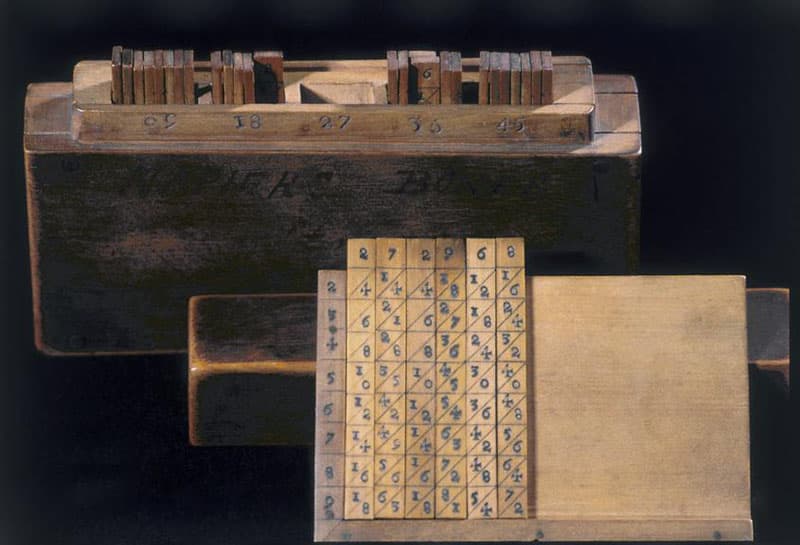
He used 9 different ivory strips or bones marked with numbers to multiply and divide in this calculating tool. So, the device became known as Napier’s Bones. It was also the first machine to use the decimal point.
4. The Slide Rule (1620-1230 AD)
The slide rule was invented around 1620–1630 AD, shortly after John Napier publicized the concept of the logarithm. In 1620 Edmund Gunter of Oxford developed a calculating device with a single logarithmic scale. In 1622, William Oughtred of Cambridge combined two handheld Gunter rules to make a device that is recognizably the modern slide rule.

The slide rule is considered the first analog computing device that works on the logarithms principle. The slide rule was used until the mid-1970s, when the first handheld calculators and microcomputers appeared.
5. Pascaline (1623-1662 AD)
In 1642, Blaise Pascal, a French mathematician, invented the first mechanical machine, a rectangular brass box called Pascaline (also known as Pascal’s calculator or arithmetic machine) which could perform the addition and subtraction on whole numbers. Pascal invented this device to help his father, a tax accountant.
Pascal’s device was a wooden box with a series of gears and wheels with 10 teeth each. It represents the numbers 0 to 9. As each gear made one turn it. When a wheel is rotated one revolution, it rotates the adjoining wheel. A series of windows is given on the top of the wheels to read the totals. An image of Pascaline is shown below.

A computer programming language, Pascal, was later named to honor his contribution.
6. Stepped Reckoner or Leibnitz Wheel
In 1694 AD, a German mathematician-philosopher, Gottfried Welham Von Leibniz, enhanced the Pascaline by creating a machine called Stepped Reckoner (also known as Leibnitz calculator) that could add, subtract, multiply and evaluate square roots by series of stepped additions. Leibniz was the first to support the use of a binary number system.

Leibniz got the idea for a calculating machine in 1672 in Paris from a pedometer. Later he learned about Blaise Pascal’s device when he read Pascal’s Pensees. He focused on expanding Pascal’s mechanism so it could multiply and divide.
7. Jacquard’s Loom Machine
In 1804, Joseph Marie Jacquard, a French silk weaver, invented a device fitted to an automated loom that used punched cards as a pattern to weave complex designs and patterns. The resulting ensemble of the Jacquard machine and the loom is then called a Jacquard Loom.
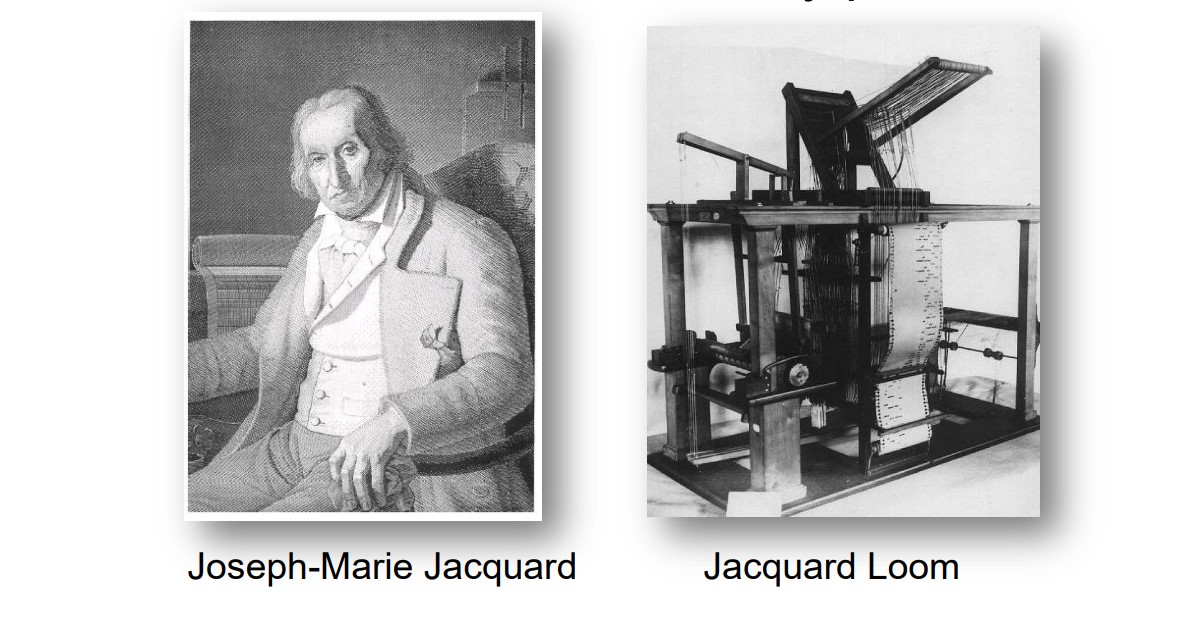
A chain of cards controlled the machine; several punched cards laced together into a continuous sequence. Numerous rows of holes were punched on each card, with one complete card corresponding to one design row. This use of replaceable punched cards to control a series of operations is considered an essential step in the history of computing hardware, having inspired Charles Babbage’s Analytical Engine.
8. Difference Engine & Analytical Engine (Babbage’s Engine)
A British mathematician at Cambridge University, Charles Babbage, invented the first Difference Engine or Analytical Engine.
In 1822, Charles Babbage conceptualized and began inventing the Difference Engine, believed the first automatic computing machine could approximate polynomials. The Difference Engine was adept at computing several sets of numbers and making hard copies of the results. Babbage received some help with inventing the Difference Engine from Ada Lovelace, considered the first computer programmer for her work.
Unfortunately, Babbage could never finish a full-scale functional version of this machine because of funding. In June 1991, the London Science Museum completed the Difference Engine No 2 for the bicentennial year of Charles Babbage’s birth and later finished the printing mechanism in 2000.
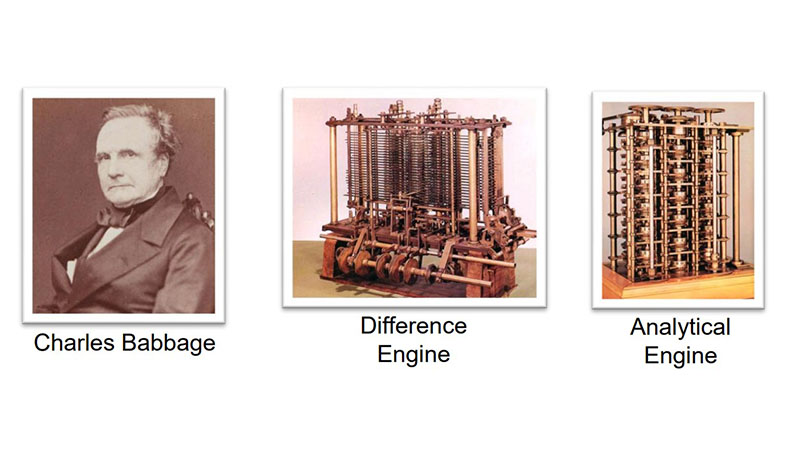
In 1837, Charles Babbage proposed Analytical Engine, the first general mechanical computer. The Analytical Engine contained:
- An Arithmetic Logic Unit (ALU).
- Punch cards (inspired by the Jacquard Loom).
- Integrated memory.
- Basic flow control.
It is the first general-purpose computer concept that could be used for multiple things and not only one particular computation.
Unfortunately, this computer was also never built while Charles Babbage was alive because of budget issues. In 1910, Charles Babbage’s youngest son, Henry Babbage, completed a portion of this machine and performed some basic calculations.
Charles Babbage is known as ‘the father of the modern digital computer’ for his contributions.
9. Lady Augusta Ada Lovelace (First Computer Programmer )
Lady Augusta Byron, Countess of Lovelace (1815 – 1852 AD), was an English mathematician mainly known for her work on Charles Babbage’s proposed mechanical general-purpose computer, the Analytical Engine. She advised Charles Babbage to use a binary number system to feed programs and data into an analytical engine.
She was the first to acknowledge that the machine had applications beyond pure calculation and posted the first algorithm intended to be carried out by such a machine. As a result, she is often considered as the first computer programmer. A programming language named “Ada” is named after her.
10. Scheutzian Calculation Engine
Pehr (Per) Georg Scheutz (1785 – 1873 AD) was a Swedish lawyer, translator, and inventor, who is now best known for his excellent work in computer technology. He is most known for the Scheutzian Calculation Engine, invented in 1837 and finalized in 1843. This machine, which he made with his son Edvard Scheutz, was based on Charles Babbage’s Difference engine.

In 1851 they received funds from the government to build an improved model, built-in 1853 (roughly a piano’s size) and subsequently demonstrated at the World’s Fair in Paris, 1855. The device was used for creating logarithmic tables.
11. Tabulating Machine
In 1890, Herman Hollerith, an American statistician, invented the Tabulating Machine. It was a mechanical tabulator based on punch cards that could tabulate statistics and record or sort data or information. The machine was also used to tabulate the 1890 US census in a record time. Hollerith’s machine was approximately ten times faster than manual tabulations and saved the census office millions of dollars.
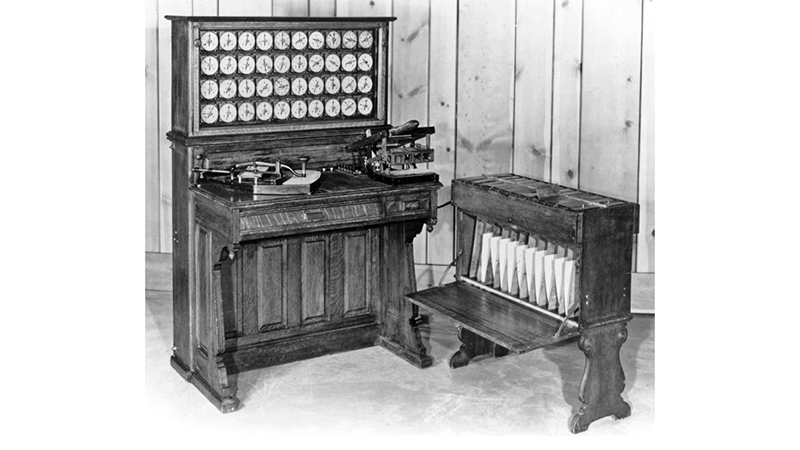
Hollerith also started Hollerith’s Tabulating Machine Company in 1896 AD, which later became International Business Machine (IBM) in 1924 AD.
12. Havard Mark 1
Harvard Mark I is also known as IBM Automatic Sequence Controlled Calculator (ASCC). Howard Aiken of Harvard University designed the first fully automatic calculating machine in collaboration with IBM. It was the first programmable digital computer.
Harvard Mark I was an electronic relay computer as Electromagnetic signals were used for the movement of mechanical components. It could perform basic arithmetic and complex equations. Although this device was highly reliable, it was very slow (it took about 3-6 seconds per calculation) and was large in size and complex in design.
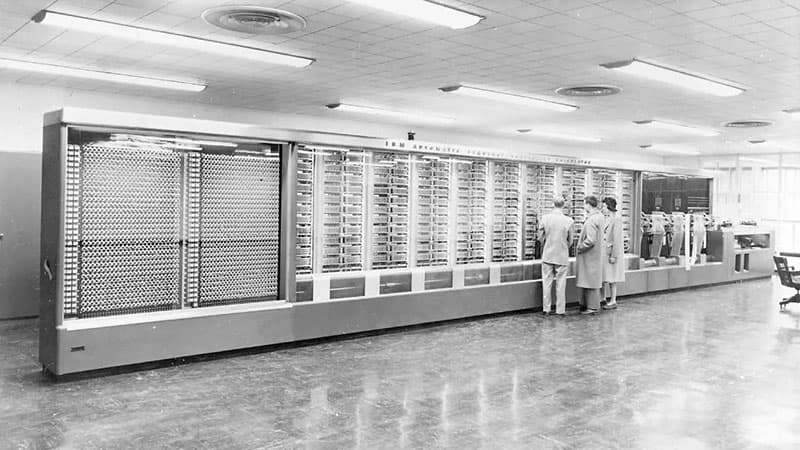
On 29 March 1944, one of the first programs to run on the Mark I was initiated by John von Neumann. Mark I also computed and printed mathematical tables, which had been the initial dream of Charles Babbage for his “Analytical Engine” in 1837.
13. The Z1 – First Programmable Computer
Konrad Zuse invented the Z1 in his parent’s living room from 1936 to 1938. It is considered the first modern computer and the first electromechanical binary programmable computer. It was a binary electrically operated mechanical calculator with limited programmability, reading instructions from punched celluloid film.

It was completed in 1938 and funded entirely from private funds. This computer was demolished in the bombardment of Berlin in December 1943, during World War II, together with all construction plans.
Konrad Zuse would also later invent the Z3, the first functioning programmable computer that could be fully automated.
14. Atanasoff-Berry Computer (ABC) – The First Digital Computer
Short for Atanasoff-Berry Computer, the ABC was the world’s first general-purpose electronic digital computer that began development by Professor John Vincent Atanasoff and his student Cliff Berry in 1937. Its evolution continued until 1942 at the Iowa State College.
The ABC was an electrical computer that used more than 300 vacuum tubes for digital computation, including Boolean logic and binary math, and had no CPU (it was not programmable). It made use of vacuum tubes for internal logic and capacitors for storage.
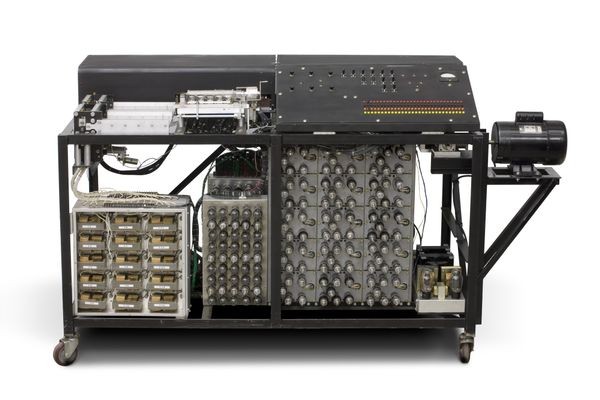
On October 19, 1973, US Federal Judge Earl R. Larson signed his judgment that the ENIAC patent by J. Presper Eckert and John Mauchly was invalid. In conclusion, Larson named Atanasoff, the sole inventor.
15. Osborne 1 – The First Portable Computer
The Osborne 1 is the first portable computer, developed by Adam Osborne and designed by Lee Felsenstein, released on April 3, 1981 AD, by Osborne Computer Corporation. It weighs 11.1 kg, costs $1,795 and runs the CP/M 2.2 OS. It is powered from a wall socket, as it has no battery, but it is still tagged as a portable device since it can be hand-carried when the keyboard is closed.
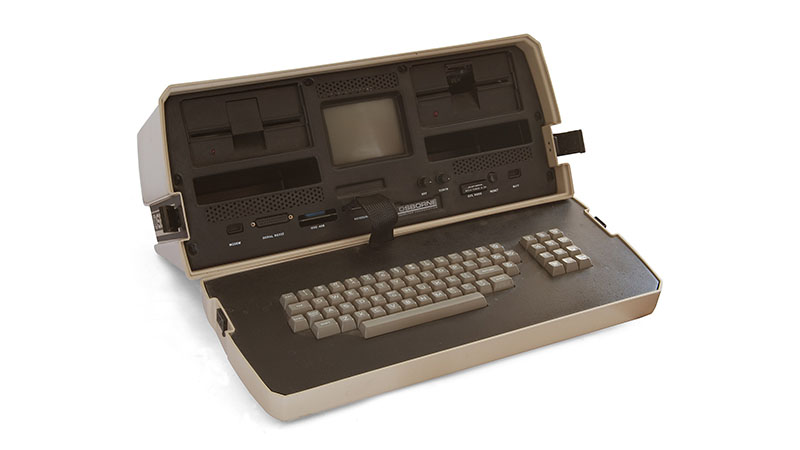
The computer shipped with a bundle of software that was equivalent in value to the machine itself. The Osborne 1 is about the size and weight of a sewing machine and was publicized as the only computer that would fit under an airline seat.
16. Electronic Controls Company – The First Computer Company
Founded in 1949 by J. Presper Eckert and John Mauchly, Electronic Controls Company was the first computer company. The company was founded by the same individuals who helped create the ENIAC computer. Later, the company was renamed Eckert-Mauchly Computer Corporation (EMCC) and released a series of mainframe computers under the UNIVAC name.
In 1950, the company was sold to Remington Rand, which later joined with Sperry Corporation to become Sperry Rand and survives today as Unisys.
In order to have a better idea of the evolution of computers, it is worthwhile to discuss the well-known early computers. We can categorize the generation of computers into five generations based on the technology used at that time. These are as follows:
Evolution of Computers [Generations of Computers]
Computer generation is a classification of computers into different groups according to their manufacturing date, memory device, software and hardware technologies. There are five generations of computers. They are as follow:
- First Generation (1942-1955)
- Second Generation (1955-1964)
- Third Generation (1964-1975)
- Fourth Generation (1975-1989)
- Fifth Generation (1989-Present)
| Generation Features | First Generation | Second Generation | Third Generation | Fourth Generation | Fifth Generation |
| Time Period | 1945 – 1956 AD | 1956 – 1963 AD | 1964 – 1971 AD | 1971 – Present | Present – Future |
| Processing Device | Vacuum Tube based | Transistor based | Integrated Circuit based | Microprocessor based | Artificial Intelligence based |
| Memory | Magnetic Drum | Magnetic Tape | High Memory Devices | CD, DVD & Hard Drive | Artificial Intelligence |
| Language | Machine & Assembly | COBAL & FORTRAN | COBOL, FORTRAN & C | C++, PERL, PYTHON & SQL | MERCURY, LISP, OPS5 & PROLOG |
| Operating System | Batch Processing OS | Time Sharing OS | Real Time OS | Micro Kernal, Multiple Windows | KIPS |
| Example | ENIAC, EDVAC & UNIVAC | IBM 1401, IBM 1620 & CDC 3600 | IBM 360 SERIES, IBM 370, UNIVAC 1108 & UNIVAC AC 9000 | MAC Notebook, IBM-PC & Pentium I, II & III. | Robots |
1. The First Generation Computers (1945-1956 AD)
First-generation computers bore little resemblance to today’s computers, either in appearance or performance. The first generation of computers occurred from 1940 AD to 1956 AD and was extremely large in size. The internal workings of the computers at that time were unsophisticated. These early machines required vacuum tubes that worked as switches, amplifiers, and magnetic drums for memory. The paper tapes and punch cards were used for input and printouts for output.
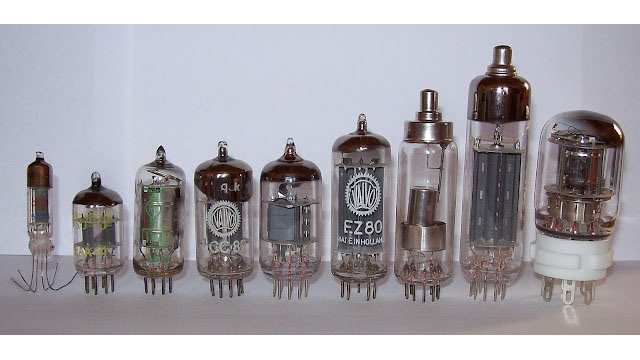
The vacuum tubes were primarily responsible for the large size of the devices and the enormous amounts of heat that they released despite large cooling units. First-generation computers also used a very basic programming language that is referred to as machine language.
Features of First Generation Computers
Following are some of the features of first generation computers −
- It was a large mainframe built with vacuum tube technology.
- It occupied large space, was low efficiency and unreliable due to low accuracy.
- The power consumption was very high, and it produced massive heat.
- The operation of speed was in milliseconds.
- It was used only for scientific or research purposes.
- Low-level programming language was used in computers.
- They were very slow.
Limitations of First Generation Computers
Following are some of the limitations of first generation computers −
- The computer needed an air conditioner room, and constant maintenance.
- They were not portable.
- It was expensive commercial product.
- They have minimum programming capabilities.
- The computers have limited uses only.
Examples of First Generation Computers
Some of the examples of the first generation computer are as follows:
- ENIAC (Electronic Numerical Integrator and Calculator)
- EDVAC (Electronic Discrete Variable Automatic)
- UNIVAC (Universal Automatic Computers)
- IBM-701
- IBM-650
ENIAC (Electronic Numerical Integrator and Calculator) (1943-46 AD)
The Electronic Numerical Integrator And Calculator (ENIAC) was the first all-electronic computer. It was constructed at the Moore School of Engineering of the University of Pennsylvania, U.S.A., by a design team led by Professors J. Presper Eckert and John Mauchly.

The team developed ENIAC because of military needs. It was used for many years to solve ballistic-related problems. ENIAC took up wall space in a 20 x 40 square feet room and used 18,000 vacuum tubes. It could add two numbers in 200 microseconds and multiply them in 2000 microseconds.
Did You Know?
Baron Gottfried Wilhelm von Leibniz of Germany invented the first calculator for multiplication.
EDVAC (Electronic Discrete Variable Automatic) (1946-52 AD)
A major disadvantage of ENIAC was that its programs were wired on boards which made it difficult to change the programs. Dr. John Von Neumann later introduced the ―stored program concept that aided overcome this problem. The basic idea after this concept is that a sequence of instructions and data can be stored in a computer’s memory to direct operations flow automatically. This feature largely influenced the development of modern digital computers because of how various programs can be loaded and executed on the same computer. Because of this feature, we usually refer to modern digital computers as stored-program digital computers.

The Electronic Discrete Variable Automatic Computer (EDVAC) used the stored’ program concept in its design. Von Neumann also has a share of the credit for introducing the idea of storing both instructions and data in binary form (a system that uses only two digits – 0 and 1 to represent all characters), instead of decimal numbers or human-readable words.
UNIVAC (Universal Automatic Computers) (1951)
The Universal Automatic Computer (UNIVAC) was the first digital computer that was not ―one of a kind. Many UNIVAC machines were manufactured, the first of which was installed in the Census Bureau in 1951 and was used continually for 10 years.
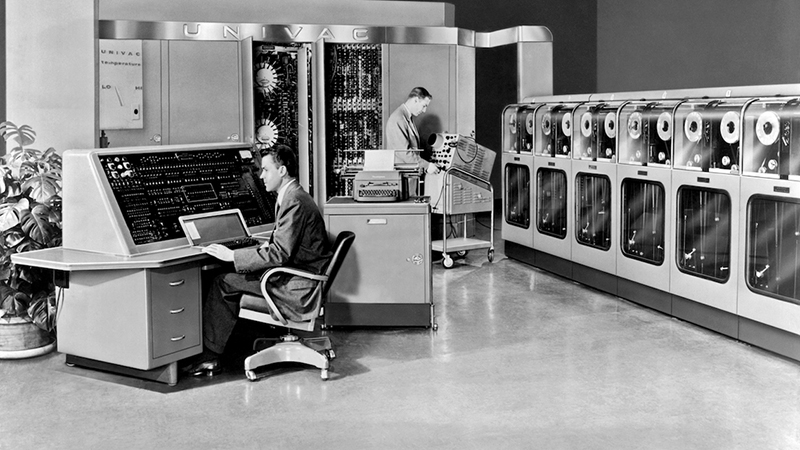
In 1952, the International Business Machines (IBM) Corporation introduced the IBM-701 commercial computer. In quick succession, improved models of the UNIVAC I and other IBM 700-series machines were introduced. In 1953, IBM produced the IBM-650 and sold over 1000 computers.
Did You Know?
UNIVAC marked the arrival of commercially available digital computers for business and scientific applications and was developed by General Electric Corporation in 1954.
2. Second Generation Computers (1956-1963 AD)
The interest in computer technology got fast after the first-generation computers. It was the generation of Transistorized Computers. Transistors replaced vacuum tubes from the first generation computers. As a result, first-generation computers were replaced by second-generation computers.
The transistors were more reliable than vacuum tubes, smaller in size, faster in speed, and cheap[er than first-generation computers. Magnetic drums are replaced by magnetic disks and magnetic tape for secondary storage. As a result, the size of the machines began shrinking.
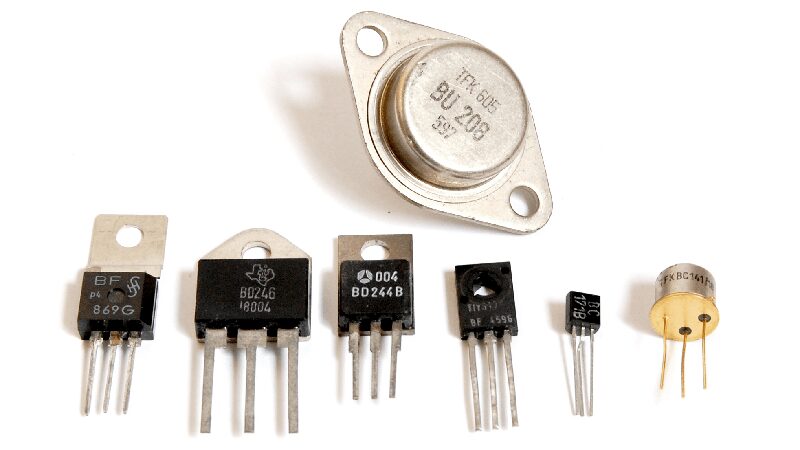
The first transistorized computer was TX-0. The first large-scale machines that took advantage of the transistor technology were the early supercomputers, LARC by Sperry Rand and Stretch by IBM. These machines were specially developed for atomic energy laboratories. IBM 1400 and IBM 7000 series, General Electric, and Honeywell 200 were the typical computers of the second generation.
IBM 1401 was accepted throughout the industry, and most prominent businesses routinely processed financial information using second-generation computers. The machine language was replaced by assembly language. Thus the long and challenging binary code was replaced with abbreviated programming code, which was relatively easy to understand.
The programming languages and stored program concept gave the computers flexibility to be cost-effective and productive for business use. The stored program concept implied that the instructions to run a computer for a specific task were held inside the computer’s memory and could quickly be modified or replaced by a different set of instructions for a different function.
High-level languages like FORTRAN, COBOL, and AL- GOL were developed. Computers started finding varied and vast applications. The entire software industry began with second-generation computers.
Features of Second Generation Computers
Following are some of the features of second generation computers −
- This generation’s most significant feature was introducing transistors that make the size smaller than the first-generation computer.
- The computer was much faster, more reliable, and better speed and could handle enormous data than first-generation computers.
- The machine-level language was replaced by assembly language and machine-independent language such as COBOL FORTRAN to simplify programming.
- The significant change is in speed from millisecond to microsecond.
- The computer consumes less electrical power than a first-generation computer.
- The computer is widely used in commercial areas.
Limitations of Second Generation Computers
Following are some of the limitations of second generation computers −
- It still used a cooling system to cool down the computer.
- It needs constant maintenance.
- Punch cards are still used for inputs.
- It was still costly and versatile.
Examples of Second Generation Computers
Some of the examples of the second generation computer are as follows:
- IBM 1401 (Used in Bussiness Application)
- IBM 1620 (Used for Scientific Purposes)
- CDC 3600 (Used for Scientific Purposes)
- IBM 7000
- Honeywell 200
3. Third Generation Computers (1964-1971 AD)
Its period was around 1964 to 1971. Third-generation computers were characterized by the invention of Integrated Circuits (ICs). IC is a silicon chip made from quartz where multiple transistors were placed over it. Robert Noyce and Jack Kilby developed IC at Texas Instrument in 1958-1959. Later, even more components were rigged onto a single chip, called a semiconductor. It reduced the size even further in the third generation computers. Computers’ weight and power consumption decreased, and the speed boosted.
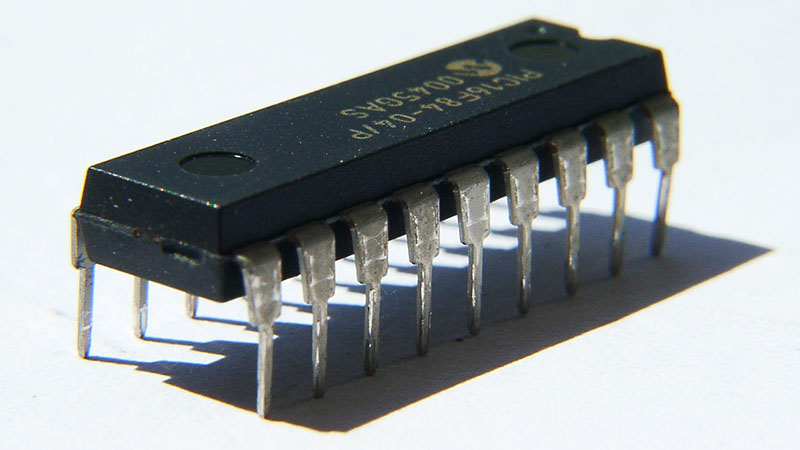
Operating systems were created, allowing the machine to run many different programs simultaneously. Multiprogramming was made possible, whereby the device could perform several jobs simultaneously.
Computers gained the speed of executing millions of instructions per second. Commercial production became more accessible and cheaper. Higher-level languages like Pascal and Report Program Generator (RPG) were introduced. And applications-oriented languages like FORTRAN, COBOL, and PL/1 were developed. Keyboards and mouse were introduced for the input of data. The monitor was introduced for the output of data.
Features of Third Generation Computers
Following are some of the features of third generation computers −
- IC was used in the computer, replacing transistors.
- The mass audience was using computers.
- The computers were highly reliable, relatively inexpensive, faster, and more accurate.
- It can be operated with low energy, and maintenance cost was low also.
- The keyboard and monitor were introduced for data input and output.
- It had a more prominent space capacity.
- A computer has more high-level computer language such as ALGOL-68, FORTRAN-II TO IV, BASIC, COBOL, PASCAL PL/1.
- They were produced commercially and was cheaper than both generations of computer.
Limitations of Third Generation Computers
Following are some of the limitations of third generation computers −
- Still, the air conditioner is used for cooling purposes.
- Highly sophisticated technology was required for the maintenance of the ICS chip.
- For third-generation computers, formal training was needed.
Examples of Third Generation Computers
Some of the examples of the third generation computer are as follows:
- IBM 360 SERIES
- IBM 370
- UNIVAC 1108
- UNIVAC AC 9000
- PDP-8, PDP-11
- ICL 2900 series, and so on.
4. Fourth Generation Computers (1971 – Present)
The fourth-generation computers were developed from 1971 to 1990 AD. The present-day computer we see is the fourth generation of computers. The third generation computers used Integrated Circuits with 10-20 components on each chip; this was Small Scale Integration (SSI). The Fourth Generation acknowledged Large Scale Integration (LSI), which could hold hundreds of components on one chip, and Very Large Scale Integration (VLSI), which embraced thousand of components on one silicon chip.
The Intel 4004 chip hold all the components of a computer (central processing unit (CPU), input and output controls, memory unit) on a single chip called a Microprocessor, and microcomputers were introduced.

In this generation, the concept of computer networks and CD-ROMS come into existence. GUI and pointing devices facilitate easy use and learning on the computer. Many new operating systems like the MS-DOS and MS-Windows developed during this time. Computer production became affordable, and the era of Personal Computers (PCs) began.
In 1981, IBM introduced its personal computer for home, office, and schools. In direct competition, the Macintosh was introduced in 1984 by Apple. Shared interactive systems and user-friendly environments were the features of these computers.
Features of Fourth Generation Computers
Following are some of the features of fourth generation computers −
- Computer sizes change from desktop to laptop and from laptop to palmtop.
- Electronic Mail (E-mail) and the Internet were developed in this generation.
- The computer is used for all scientific, engineering, and commercial purposes.
- On the computer, we can perform multiprocessing and multitasking.
- The computer has GUI (Graphical User Interface) and is user-friendly.
- Multiple high-level languages like PASCAL, BASIC COBOL, FORTRAN, and C language were developed in this generation of computers.
- They emerged as single-board computers and a single-chip processor called Microprocessors.
Limitations of Fourth Generation Computers
Following are some of the limitations of fourth generation computers −
- They were highly sophisticated.
- The manufacturing of a Very Large-Scale Integration Chip needed very advanced technology.
Examples of Fourth Generation Computers
Some of the examples of the fourth generation computer are as follows:
- MAC Notebook
- IBM-PC
- Pentium I, II & III
- Apple II
- VAX 9000
- CRAY 1
5. Fifth Generation Computers (Present – Furture)
Defining the fifth generation of computers is tricky because the field is still in its infancy. Tomorrow’s computers would be characterized by Artificial Intelligence (AI) and ULSI (Ultra Large-Scale Integration) technology that can store millions of components in a single chip. An example of Al is Expert Systems. Computers could be developed to think and sense much the same way as humans. Computers would be able to accept verbal words as input (voice recognition).
Numerous advancements in the science of computer design and technology are coming together to enable the creation of fifth-generation computers. Two such advances are in superconductor technology that allows electricity flow with little or no resistance, significantly enhancing the speed of information flow, and advances in parallel processing, where many CPUs work as one.
Scientists are now working on fifth-generation computers – a promise but not yet a reality. They seek to bring us machines with genuine I.Q., the ability to reason logically, and real-world knowledge.
Features of Fifth Generation Computers
Following are some of the features of fifth generation computers −
- These machines will incorporate ULSI (Ultra Large Scale Integration).
- It can perform a large number of parallel processing.
- The speed of this generation of computers is going to be very high.
- Bio-chips and Gallium Arsenide (GaAs) are used as memory devices.
- The concept of AI (Artificial Intelligence) has been introduced.
- This generation of computers can understand human language and recognize pictures and graphs.
Limitations of Fifth Generation Computers
Following are some of the limitations of fifth generation computers −
- The major limitation of this generation is that the computer will overtake all employment, creating unemployment in the country.
- The highly advanced robots can overtake the world, which leads to destruction for humans.
